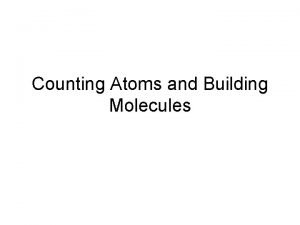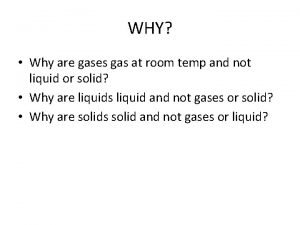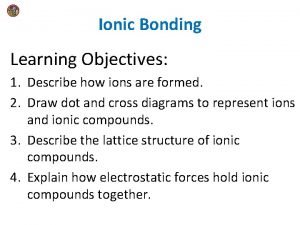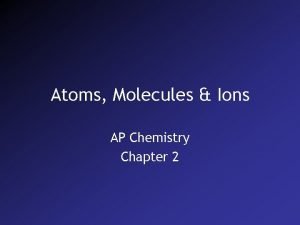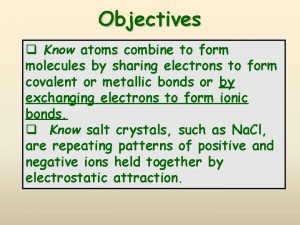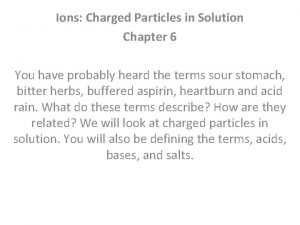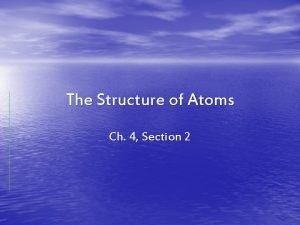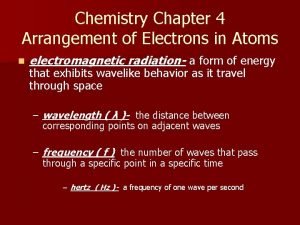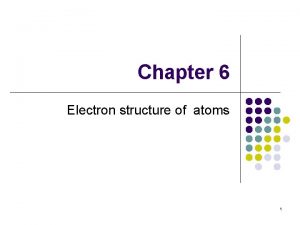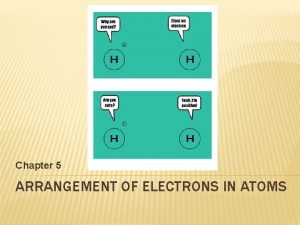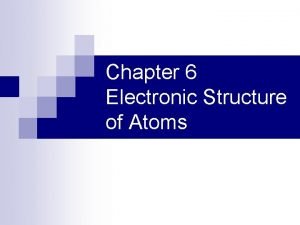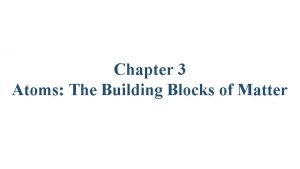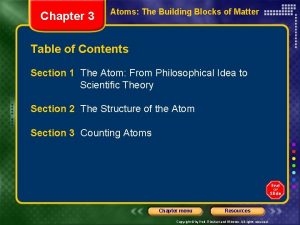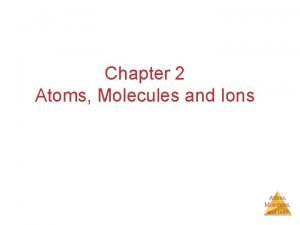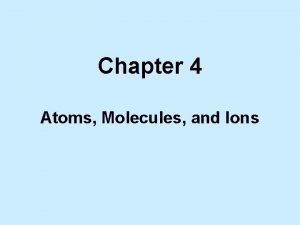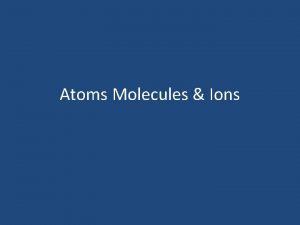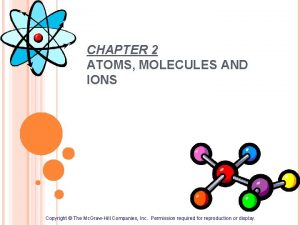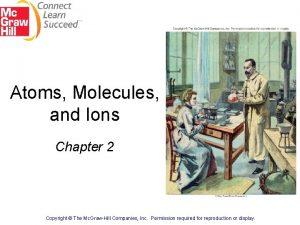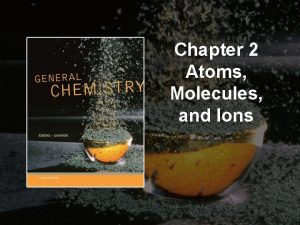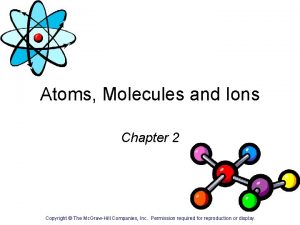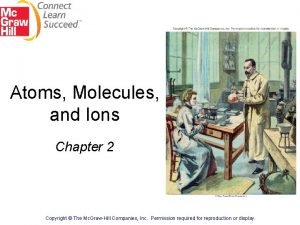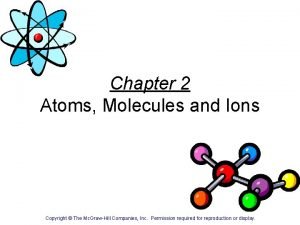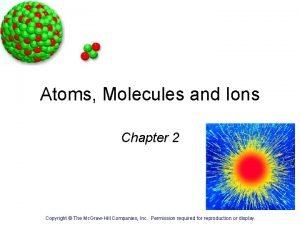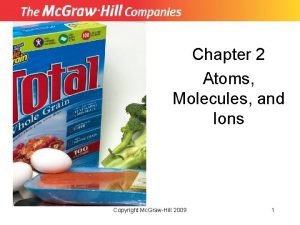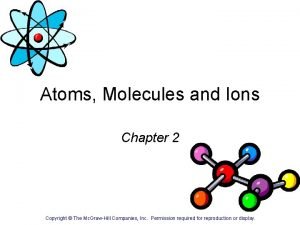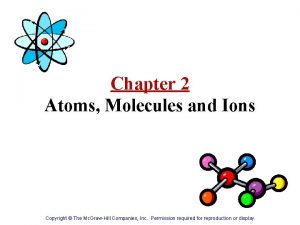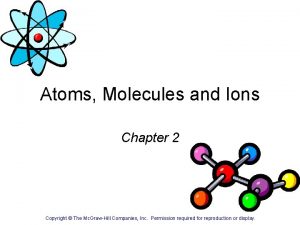Chapter 2 Atoms Molecules and Ions Copyright The














































- Slides: 46

Chapter 2 Atoms, Molecules and Ions Copyright © The Mc. Graw-Hill Companies, Inc. Permission required for reproduction or display.

Chapter 2 (p. 49 -68) • • Atomic number , mass number and isotopes. The periodic table. Molecules and ions. Chemical formulas. Naming compounds. Tables 2. 1 - 2. 2 – 2. 3 – 2. 4 - 2. 5 – 2. 6 – 2. 7 Examples 2. 1 - 2. 2 – 2. 3 – 2. 4 – 2. 5 – 2. 6 – 2. 7 – 2. 8 – 2. 9

mass p = mass n = 1840 x mass e 2. 2

Atomic number, Mass number and Isotopes Atomic number (Z) = number of protons in nucleus Mass number (A) = number of protons + number of neutrons = atomic number (Z) + number of neutrons Isotopes are atoms of the same element (X) with different numbers of neutrons in their nuclei Mass Number A ZX Atomic Number 1 1 H 235 92 2 1 H U Element Symbol (D) 238 92 3 1 H U (T) 2. 3

The Isotopes of Hydrogen 2. 3

Do You Understand Isotopes? How many protons, neutrons, and electrons are 14 in 6 C ? 6 protons, 8 (14 - 6) neutrons, 6 electrons How many protons, neutrons, and electrons are 11 in 6 C ? 6 protons, 5 (11 - 6) neutrons, 6 electrons 2. 3


Noble Gas Halogen Group Alkali Metal Alkali Earth Metal Period 2. 4

Chemistry In Action Natural abundance of elements in Earth’s crust Natural abundance of elements in human body 2. 4

A molecule is an aggregate of two or more atoms in a definite arrangement held together by chemical forces H 2 O NH 3 CH 4 A diatomic molecule contains only two atoms H 2, N 2, O 2, Br 2, HCl, CO A polyatomic molecule contains more than two atoms O 3, H 2 O, NH 3, CH 4 Allotrope is one of tow or more distinct forms of an element as O 2 , O 3. 2. 5

An ion is an atom, or group of atoms, that has a net positive or negative charge. cation – ion with a positive charge If a neutral atom loses one or more electrons it becomes a cation. Na 11 protons 11 electrons Na+ 11 protons 10 electrons anion – ion with a negative charge If a neutral atom gains one or more electrons it becomes an anion. Cl 17 protons 17 electrons Cl- 17 protons 18 electrons 2. 5

A monatomic ion contains only one atom Na+, Cl-, Ca 2+, O 2 -, Al 3+, N 3 - A polyatomic ion contains more than one atom OH-, CN-, NH 4+, NO 3 - 2. 5

Do You Understand Ions? How many protons and electrons are in 27 3+ 13 Al ? 13 protons, 10 (13 – 3) electrons How many protons and electrons are in 78 2 Se ? 34 34 protons, 36 (34 + 2) electrons 2. 5

2. 5


2. 6

A molecular formula shows the exact number of atoms of each element in the smallest unit of a substance An empirical formula shows the simplest whole-number ratio of the atoms in a substance molecular empirical H 2 O C 6 H 12 O 6 CH 2 O O 3 O N 2 H 4 NH 2 2. 6



ionic compounds consist of a combination of cations and an anions • the formula is always the same as the empirical formula • the sum of the charges on the cation(s) and anion(s) in each formula unit must equal zero The ionic compound Na. Cl 2. 6

Formula of Ionic Compounds 2 x +3 = +6 3 x -2 = -6 Al 2 O 3 Al 3+ 1 x +2 = +2 Ca 2+ 2 x +1 = +2 Na+ O 22 x -1 = -2 Ca. Br 2 Br 1 x -2 = -2 Na 2 CO 322. 6


1. An anion is defined as A. B. C. D. a charged atom or group of atoms with a net negative charge. a stable atom. a group of stable atoms. an atom or group of atoms with a net positive charge. 2. Atoms of the same element with different mass numbers are called A. B. C. D. E. ions. neutrons. allotropes. chemical families. isotopes. 3. How many neutrons are there in an atom of lead whose mass number is 208? A. B. C. D. E. 82 126 208 290 none of them

4. An atom of the isotope sulfur-31 consists of how many protons, neutrons, and electrons? (p = proton, n = neutron, e = electron) A. B. C. D. E. 15 p, 16 n, 15 e 16 p, 15 n, 16 e 16 p, 31 n, 16 e 32 p, 31 n, 32 e 16 p, 16 n, 15 e 5. A magnesium ion, Mg 2+, has A. B. C. D. E. 12 protons and 13 electrons. 24 protons and 26 electrons. 12 protons and 10 electrons. 24 protons and 22 electrons. 12 protons and 14 electrons. 6. A sulfide ion, S 2 - , has: A. B. C. D. E. 16 protons and 16 electrons 32 protons and 16 electrons 16 protons and 14 electrons 16 protons and 18 electrons 32 protons and 18 electrons

Answer Key 1 -A 2 -E 3 -B 4 -B 5 -C 6 -D • Problems • 2. 10 – 2. 11 – 2. 12 – 2. 14 – 2. 16 – 2. 18 • 2. 26 - 2. 34 – 2. 36 – 2. 44 – 2. 46 – 2. 50

Chemical Nomenclature • Ionic Compounds – often a metal + nonmetal – anion (nonmetal), add “ide” to element name Ba. Cl 2 barium chloride K 2 O potassium oxide Mg(OH)2 magnesium hydroxide KNO 3 potassium nitrate 2. 7

2. 7

2. 7

• Transition metal ionic compounds – indicate charge on metal with Roman numerals Fe. Cl 2 2 Cl- -2 so Fe is +2 iron(II) chloride Fe. Cl 3 3 Cl- -3 so Fe is +3 iron(III) chloride Cr 2 S 3 3 S-2 -6 so Cr is +3 (6/2) chromium(III) sulfide 2. 7

• Molecular compounds • nonmetals or nonmetals + metalloids • common naes • H 2 O, NH 3, CH 4, C 60 • element further left in periodic table is 1 st • element closest to bottom of group is 1 st • if more than one compound can be formed from the same elements, use prefixes to indicate number of each kind of atom • last element ends in ide 2. 7

Molecular Compounds HI hydrogen iodide NF 3 nitrogen trifluoride SO 2 sulfur dioxide N 2 Cl 4 dinitrogen tetrachloride NO 2 nitrogen dioxide N 2 O dinitrogen monoxide TOXIC! Laughing Gas 2. 7

2. 7

An acid can be defined as a substance that yields hydrogen ions (H+) when dissolved in water. HCl • Pure substance, hydrogen chloride • Dissolved in water (H+ Cl-), hydrochloric acid An oxoacid is an acid that contains hydrogen, oxygen, and another element. HNO 3 nitric acid H 2 CO 3 carbonic acid H 2 SO 4 sulfuric acid HNO 3 2. 7

2. 7

2. 7

2. 7

A base can be defined as a substance that yields hydroxide ions (OH-) when dissolved in water. Na. OH sodium hydroxide KOH potassium hydroxide Ba(OH)2 barium hydroxide 2. 7

Hydrates are compounds that have a specific number of water molecules attached to them. Ba. Cl 2 • 2 H 2 O barium chloride dihydrate Li. Cl • H 2 O lithium chloride monohydrate Mg. SO 4 • 7 H 2 O magnesium sulfate heptahydrate Sr(NO 3)2 • 4 H 2 O strontium nitrate tetrahydrate Cu. SO 4 • 5 H 2 O Cu. SO 4 2. 7

2. 7





Worked Example 2. 9

7. Which compound has the same empirical formula as C 6 H 12 O 6? A) C 12 H 24 O 12 B) C 3 H 3 O 3 C) CH 2 ON D) CHO 2 8. Which of the following compounds is named lithium carbonate? A) Na 2 CO 3 B) Li. HCO 3 C) Li. CO D) Li 2 CO 3 9. What is the name of KCl. O? A) potassium chlorite B) potassium chloride C) potassium hypochlorite D) potassium oxide 10. What is the formula for ammonium sulfate? A) NH 4 SO 4 B) NH 4(SO 4)2 C) (NH 4)2 SO 4 D) NH 4 S

Answer Key 7 -A 8 -D 9 -C • Problems • 2. 58 – 2. 60 – 2. 94 10 -C
 Chapter 2 atoms molecules and ions
Chapter 2 atoms molecules and ions Atoms molecules and ions
Atoms molecules and ions Atoms molecules and ions
Atoms molecules and ions Atoms molecules and ions
Atoms molecules and ions Atoms molecules and ions
Atoms molecules and ions Atoms ions and molecules
Atoms ions and molecules Atoms ions and molecules
Atoms ions and molecules States that atoms ions and molecules must collide to react
States that atoms ions and molecules must collide to react Positive ions and negative ions table
Positive ions and negative ions table What is the relationship between atoms and elements
What is the relationship between atoms and elements Mixture of compounds diagram
Mixture of compounds diagram 3bacl2 counting atoms
3bacl2 counting atoms Interacting molecules or ions
Interacting molecules or ions Organic molecules vs inorganic molecules
Organic molecules vs inorganic molecules Positive ions are atoms that have
Positive ions are atoms that have Atoms or ions are considered isoelectronic if
Atoms or ions are considered isoelectronic if Atoms combine to form
Atoms combine to form Regents periodic table
Regents periodic table Chapter 6 section 1 atoms elements and compounds answer key
Chapter 6 section 1 atoms elements and compounds answer key Chapter 6 section 1 atoms elements and compounds
Chapter 6 section 1 atoms elements and compounds Modern chemistry chapter 13
Modern chemistry chapter 13 Ions charged particles in solution
Ions charged particles in solution Chapter 3 molecules of life
Chapter 3 molecules of life Chapter 4 section 2 the structure of atoms answer key
Chapter 4 section 2 the structure of atoms answer key Chapter 4 arrangement of electrons in atoms test
Chapter 4 arrangement of electrons in atoms test Stable electron configurations are likely to contain
Stable electron configurations are likely to contain Chapter 6 electronic structure of atoms answers
Chapter 6 electronic structure of atoms answers Chapter 5 review arrangement of electrons in atoms
Chapter 5 review arrangement of electrons in atoms Electronic structure of atoms
Electronic structure of atoms Chapter 3 atoms the building blocks of matter
Chapter 3 atoms the building blocks of matter Chapter 3 atoms the building blocks of matter
Chapter 3 atoms the building blocks of matter Hát kết hợp bộ gõ cơ thể
Hát kết hợp bộ gõ cơ thể Slidetodoc
Slidetodoc Bổ thể
Bổ thể Tỉ lệ cơ thể trẻ em
Tỉ lệ cơ thể trẻ em Chó sói
Chó sói Tư thế worm breton
Tư thế worm breton Chúa sống lại
Chúa sống lại Các môn thể thao bắt đầu bằng tiếng đua
Các môn thể thao bắt đầu bằng tiếng đua Thế nào là hệ số cao nhất
Thế nào là hệ số cao nhất Các châu lục và đại dương trên thế giới
Các châu lục và đại dương trên thế giới Công của trọng lực
Công của trọng lực Trời xanh đây là của chúng ta thể thơ
Trời xanh đây là của chúng ta thể thơ Mật thư tọa độ 5x5
Mật thư tọa độ 5x5 Làm thế nào để 102-1=99
Làm thế nào để 102-1=99 Phản ứng thế ankan
Phản ứng thế ankan Các châu lục và đại dương trên thế giới
Các châu lục và đại dương trên thế giới











